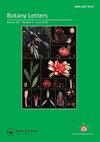The “true Boerhaave herbarium”: an analysis of the specimens of Herman Boerhaave (1668–1738) contained in the Van Royen collection at naturalis
IF 1.3
4区 生物学
Q3 PLANT SCIENCES
引用次数: 0
Abstract
ABSTRACT Collecting plants and making herbarium specimens was quintessential for an eighteenth century botanist. Studying the extant plant specimens from this period can give us valuable insights into how scholars approached the science of botany. Several dried plant specimens in the 18th-century Van Royen collection kept at Naturalis, Leiden, have at one time been recognised as originating from Herman Boerhaave (1668–1738). The aim of this study is to establish which specimens come from Boerhaave and try to answer the question why relatively few of these survived. We verified which specimens came from Boerhaave and updated the existing identifications of 88 specimens. We studied the way the specimens were mounted, the handwritings on the various labels and the use of decorations. We taxonomically identified them and linked the accompanying labels to the seed register of the Leiden Hortus Botanicus, where these specimens originated from. The transcription of the labels provided us with valuable information about the introduction and cultivation of indigenous and exotic, predominantly Mediterranean, plant species. Little effort has been put into connecting the contribution by Boerhaave with the living collection of the Leiden Hortus botanicus at the time, that is, the herbarium specimens we now know to have been described by Boerhaave. By studying these specimens we made his contribution visible.“真正的布尔哈夫植物标本馆”:对自然博物馆Van Royen收藏的赫尔曼·布尔哈夫(1668-1738)标本的分析
摘要采集植物和制作植物标本是十八世纪植物学家的精髓。研究这一时期现存的植物标本可以让我们深入了解学者们是如何对待植物学的。18世纪Van Royen收藏在莱顿Naturalis的几件干燥植物标本曾一度被认为来源于Herman Boerhaave(1668-1738)。这项研究的目的是确定哪些标本来自Boerhaave,并试图回答为什么这些标本中存活下来的相对较少的问题。我们验证了哪些标本来自Boerhaave,并更新了88个标本的现有鉴定。我们研究了标本的安装方式、各种标签上的手写以及装饰的使用。我们对它们进行了分类鉴定,并将附带的标签与这些标本的来源地莱顿植物园的种子登记册联系起来。标签的转录为我们提供了关于引进和培育本土和外来植物(主要是地中海植物)的宝贵信息。很少有人将Boerhaave的贡献与当时莱顿植物园的活体收藏联系起来,也就是说,我们现在知道的植物标本馆标本是由Boerhaove描述的。通过研究这些标本,我们看到了他的贡献。
本文章由计算机程序翻译,如有差异,请以英文原文为准。
求助全文
约1分钟内获得全文
求助全文
来源期刊

Botany Letters
Agricultural and Biological Sciences-Plant Science
CiteScore
3.10
自引率
6.70%
发文量
54
期刊介绍:
Botany Letters is an international scientific journal, published by the French Botanical Society (Société botanique de France) in partnership with Taylor & Francis. Botany Letters replaces Acta Botanica Gallica, which was created in 1993, building on over a century of renowned publications by the Société botanique de France.
 求助内容:
求助内容: 应助结果提醒方式:
应助结果提醒方式:


